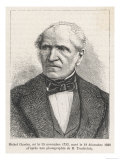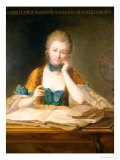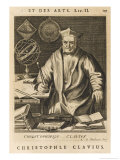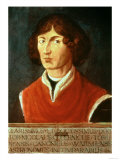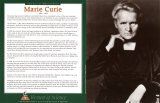|
|
|
|
|
Georg Cantor
b. 3-3-1845; St. Petersburg, Russia
d. 1-6-1918; German Empire
Mathematics professor George Cantor is best known as the inventor of set theory, a fundamental theory in mathematics.
|
|
|
|
Michel Chasles
b. 11-15-1793; Epernon, France
d. 12-18-1880; Paris
Michel Chasles was an historian of mathematics, mathematician and professor of mathematics. His first major work was “Historical view of the origin and development of methods in geometry”; he also worked on projective geometry, quadric surfaces and conic sections.
|
|
|
|
Madame Émilie du Chatelet-Lomont
b. 12-17-1706; Paris, France
d. 9-10-1749; complications of childbirth
Madame Émilie du Chatelet-Lomont was a mathematician, physicist and author. Einstein's famous equation for the energy of matter E=mc2 fits neatly with a principle recognised by Madame de Chatelet 150 years before Einstein in her book Institutions de Physique (“Lessons in Physics”), which she had prepared for her 13 year old son as a “Cliff Notes” study of the newest ideas of the time.
She translated Newton's Principia into French and was also great friends with Voltaire, (with her husband's blessing) and translated Newton's Principia into French.
|
|
|
|
Christoph Clavius
b. 3-25-1538; Bamberg, Germany
d. 2-12-1612
Christoph Clavius was a Jesuit priest, mathematician and astronomer who developed the modern Gregorian calendar.
Galileo visited Clavius to discuss the observations made with the telescope though Clavius held firm to the idea of a geocentric solar system where everything rotates around the Earth.
|
|
|
|
Copernicus
b. 2-19-1473; Torun (Thorn), Royal Prussia, Kingdom of Poland
d. 5-24-1543
Copernicus, a polymath scholar adept in mathematics, law, medicine, diplomacy, government and religion, is best known as the first European astronomer to propose a scientifically based heliocentric cosmology with the Sun at the center of the solar system.
Copernicus studied at Krakow, Bologna, Padua, and Ferrara.
|
|
|
|
H. S. M Coxeter
b. 2-9-1907; London, England
d. 3-31-2003: Toronto, Ontario, Canada
Harold Scott MacDonald Coxeter, who was an accomplished musician at the age of 10, is regarded as one of the greatest geometers of the 20th century.
The artist M. C. Escher and the architect Buckminster Fuller both drew inspiration from Coxeter's work.
|
|
|
|
Marie Curie
b. 11-7-1867; Warsaw, Poland
d. 7-4-1934; Paris - “aplastic pernicious anemia...by long accumulation to radiations”
Poster Text: The pioneering reasearch of physicist and chemist Marie Curie contributed to some of the most important new fields of study in science, from modern physics to the treatment of cancer. Madame Curie was the first woman to be awarded a Nobel Prize, the most famous honor in science. Eventually she won two Nobels. ... more
• more Women of Science posters
|
|
|
previous page | top | next
mathematics | mathematicians list | a-b | C | d | e | f-g | h-k | l-m | n | o-p-q | r-s | t-z < numbers
|
|
I have searched the web for visual, text, and manipulative curriculum support materials - teaching posters, art prints, maps, charts, calendars, books and educational toys featuring famous people, places and events - to help teachers optimize their valuable time and budget.
Browsing the subject areas at NetPosterWorks.com is a learning experience where educators can plan context rich environments while comparing prices, special discounts, framing options and shipping from educational resources.
Thank you for starting your search for inspirational, motivational, and educational posters and learning materials at NetPosterWorks.com. If you need help please contact us.
|
|
|















